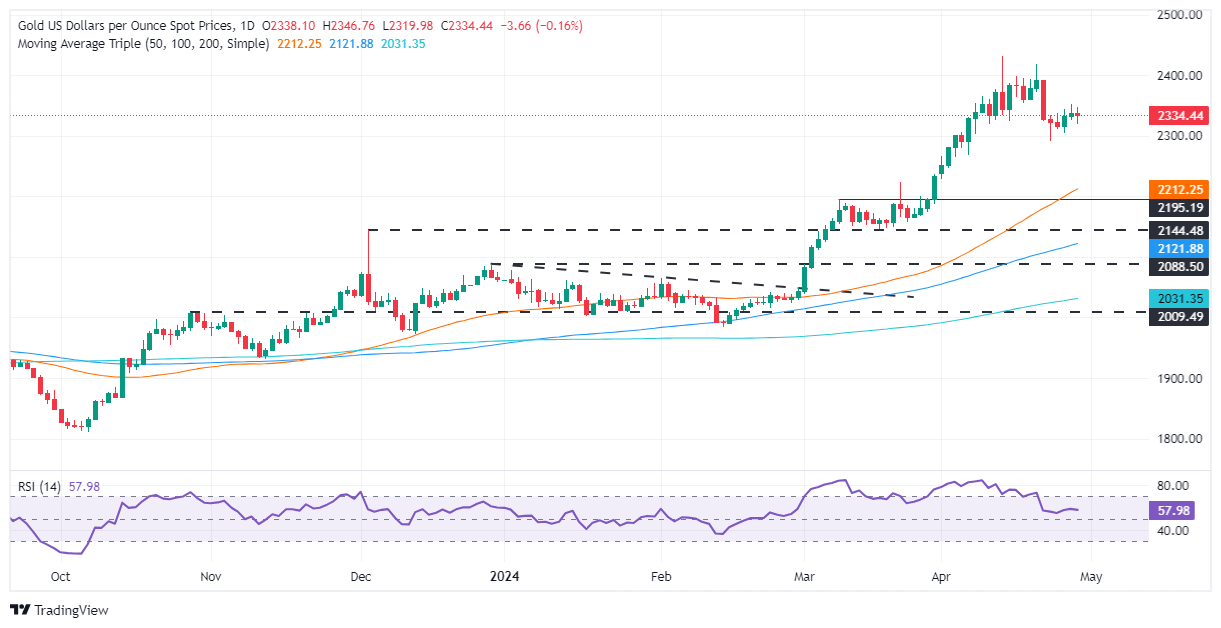- Gold continues its three-day rally, boosted by falling US Treasury yields and weakening US Dollar.
- Recent US economic data, including weak GDP performance and stable core PCE inflation rates, raise expectations that the Fed will keep rates unchanged.
- Attention now turns to the US Federal Reserve's monetary policy decision on May 1 and upcoming Nonfarm Payrolls data.
The price of Gold extends its gains for the third consecutive day, although it remains within known levels, with traders preparing for the monetary policy decision of the US Federal Reserve (Fed) on May 1. Last week, data from the United States (US) showed that the Gross Domestic Product (GDP) fell short of the expected level, while the Fed's preferred inflation indicator, the core personal consumption price index ( PCE), stagnated for the second consecutive month at 2.8% annually.
The The Fed is expected to hold interest rates on hold following Fed Chair Jerome Powell's remarks that the current monetary policy stance is appropriate given the lack of progress in curbing inflation. Additionally, investors will be watching the release of US Nonfarm Payrolls numbers on Friday.
Daily Market Summary: Gold Price Rises as US Yields Fall
- Gold's gains are supported by falling US Treasury yields and weak US Dollar. The yield on 10-year US Treasury bonds fell five basis points (bps), to 4.612%, which is a favorable wind for the non-yielding metal. At the same time, the US Dollar, as measured by the Dollar Index (DXY), gave way below 106.00, falling 0.43% and trading at 105.63.
- Last week's weaker-than-expected Gross Domestic Product (GDP) was overshadowed by the rise in the Personal Consumption Expenditure (PCE) Price Index for the first quarter of 2024, which stood at 3.7% . Although this spooked investors, who ruled out Federal Reserve interest rate cuts by 2024, the monthly core PCE reading of 2.8% annually relieved traders and led to an improvement in market sentiment.
- On May 3, the US Bureau of Labor Statistics (BLS) is expected to release April Nonfarm Payrolls numbers, which are expected to come in at 243,000, down from 303,000 in March. The unemployment rate is estimated to remain unchanged at 3.8%, while average hourly earnings (AHE) is likely to remain unchanged at 0.3% monthly.
- Data from the Chicago Board of Trade (CBOT) suggests that traders expect the federal funds rate to end 2024 at 5.035%, down from 5.050% last Friday.
Technical analysis: The price of Gold consolidates around $2,330
The price of Gold maintains its bullish bias, although to extend its gains, buyers need to reclaim the April 26 high of $2,352, in order to maintain hope of challenging higher prices. The next resistance would be the $2,400 mark, followed by the April 19 high at $2,417 and the all-time high at $2,431.
On the other hand, if the XAU/USD price falls below the daily low of April 15 at $2,324, this would pave the way to test $2,300. A break of this latter level would expose the April 23 low at $2,229, followed by the March 21 high at $2,222.

Frequently asked questions about Gold
Gold has played a key role in human history as it has been widely used as a store of value and medium of exchange. Today, aside from its brilliance and use for jewelry, the precious metal is considered a safe haven asset, meaning it is considered a good investment in turbulent times. Gold is also considered a hedge against inflation and currency depreciation, as it is not dependent on any issuer or government.
Central banks are the largest holders of Gold. In their aim to support their currencies in turbulent times, central banks tend to diversify their reserves and purchase Gold to improve the perception of strength of the economy and currency. High Gold reserves can be a source of confidence for the solvency of a country. Central banks added 1,136 tons of gold worth about $70 billion to their reserves in 2022, according to data from the World Gold Council. This is the largest annual purchase since records exist. Central banks in emerging economies such as China, India and Türkiye are rapidly increasing their gold reserves.
Gold has an inverse correlation with the US Dollar and US Treasuries, which are the main reserve and safe haven assets. When the Dollar depreciates, Gold tends to rise, allowing investors and central banks to diversify their assets in turbulent times. Gold is also inversely correlated with risk assets. A rally in the stock market tends to weaken the price of Gold, while sell-offs in riskier markets tend to favor the precious metal.
The price can move due to a wide range of factors. Geopolitical instability or fear of a deep recession can cause the price of Gold to rise rapidly due to its status as a safe haven asset. Being a non-yielding asset, Gold tends to rise with lower interest rates, while the higher cost of money usually weighs on the yellow metal. However, most of the movements depend on the behavior of the US Dollar (USD), as the asset is traded in dollars (XAU/USD). A strong Dollar tends to keep the price of Gold in check, while a weaker Dollar is likely to push up Gold prices.
Source: Fx Street
I am Joshua Winder, a senior-level journalist and editor at World Stock Market. I specialize in covering news related to the stock market and economic trends. With more than 8 years of experience in this field, I have become an expert in financial reporting.







